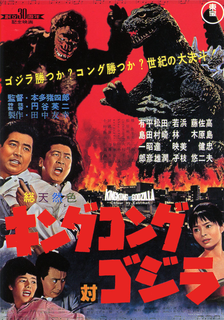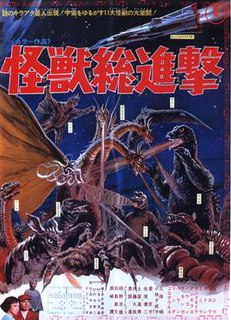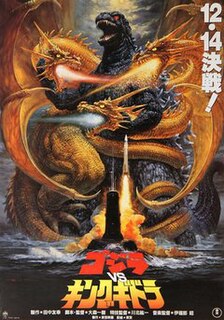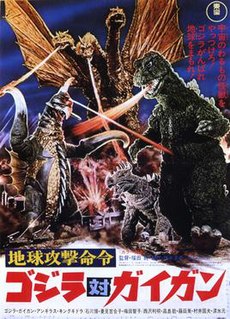Related Research Articles

King Kong vs. Godzilla is a 1962 Japanese kaiju film directed by Ishirō Honda, with special effects by Eiji Tsuburaya. Produced and distributed by Toho Studios, it is the third film in the Godzilla franchise, and the first of two Toho-produced films featuring King Kong. It is also the first time that each character appeared on film in color and widescreen. The film stars Tadao Takashima, Kenji Sahara, Yū Fujiki, Ichirō Arishima, and Mie Hama, with Shoichi Hirose as King Kong and Haruo Nakajima as Godzilla. In the film, as Godzilla is reawakened by an American submarine, a pharmaceutical company captures King Kong for promotional uses, which culminates into a battle on Mount Fuji.

Ebirah, Horror of the Deep is a 1966 Japanese kaiju film directed by Jun Fukuda and produced and distributed by Toho Studios. The film stars Akira Takarada, Kumi Mizuno, Akihiko Hirata and Eisei Amamoto, and features the fictional monster characters Godzilla, Mothra, and Ebirah. It is the seventh film in the Godzilla franchise, and features special effects by Sadamasa Arikawa, under the supervision of Eiji Tsuburaya. In the film, Godzilla and Ebirah are portrayed by Haruo Nakajima and Hiroshi Sekita.

Destroy All Monsters is a 1968 Japanese kaiju film directed by Ishirō Honda and written by Honda and Takeshi Kimura. The film, which was produced and distributed by Toho Studios, is the ninth film in the Godzilla franchise, and features eleven monster characters, including Godzilla, Mothra, Rodan, King Ghidorah, Anguirus, and Minilla. The film stars Akira Kubo, Jun Tazaki, Yukiko Kobayashi and Yoshio Tsuchiya, with special effects directed by Sadamasa Arikawa, which were provided under the supervision by Eiji Tsuburaya.

Godzilla vs. King Ghidorah is a 1991 Japanese kaiju film written and directed by Kazuki Ōmori and produced by Shōgo Tomiyama. The film, produced and distributed by Toho Studios, is the 18th film in the Godzilla franchise, and is the third film in the franchise's Heisei period. The film features the fictional monster characters Godzilla and King Ghidorah, and stars Kōsuke Toyohara, Anna Nakagawa, Megumi Odaka, Katsuhiko Sasaki, Akiji Kobayashi, Yoshio Tsuchiya, and Robert Scott Field.

Godzilla vs. Mothra is a 1992 Japanese kaiju film directed by Takao Okawara, written by Kazuki Ōmori, and produced by Shogo Tomiyama. Produced and distributed by Toho Studios, it is the 19th film in the Godzilla franchise, and is the fourth film in the franchise's Heisei era. The film features the fictional monster characters Godzilla, Mothra, and Battra, and stars Tetsuya Bessho, Satomi Kobayashi, Takehiro Murata, Megumi Odaka, Shiori Yonezawa, Makoto Otake, Akiji Kobayashi, Koichi Ueda, Shinya Owada, Keiko Imamura, Sayaka Osawa, Saburo Shinoda and Akira Takarada, with Kenpachiro Satsuma as Godzilla. The plot follows Battra and Mothra's attempts to stop Godzilla from attacking Yokohama.

Kaiju is a Japanese genre of films and television featuring giant monsters. The term kaiju can refer to the giant monsters themselves, which are usually depicted attacking major cities and engaging the military, or other kaiju, in battle. The kaiju genre is a subgenre of tokusatsu entertainment.

Rodan is a fictional monster, or kaiju, which first appeared as the title character in Ishirō Honda's 1956 film Rodan, produced and distributed by Toho. Following its debut standalone appearance, Rodan went on to be featured in numerous entries in the Godzilla franchise, including Ghidorah, the Three-Headed Monster, Invasion of Astro-Monster, Destroy All Monsters, Godzilla vs. Mechagodzilla II and Godzilla: Final Wars, as well as in the Legendary Pictures-produced film Godzilla: King of the Monsters.

Mothra is a fictional monster, or kaiju, that first appeared in the 1961 film Mothra, produced and distributed by Toho Studios. Mothra has appeared in several Toho tokusatsu films, most often as a recurring character in the Godzilla franchise. She is typically portrayed as a colossal sentient larva (caterpillar) or imago, accompanied by two miniature female humanoids speaking on her behalf. Unlike other Toho monsters, Mothra is a largely heroic character, having been variously portrayed as a protector of her own island culture, the Earth and Japan. Mothra’s design is influenced by silk worms, their imagos, and those of giant silk moths in the family saturniidae. The character is often depicted hatching offspring when approaching death, a nod to the Saṃsāra doctrine of numerous Indian religions.

King Ghidorah is a fictional monster, or kaiju, which first appeared in Ishirō Honda's 1964 film Ghidorah, the Three-Headed Monster. Although the name of the character is officially trademarked by Toho as "King Ghidorah", the character was originally referred to as Ghidorah or Ghidrah in some English markets.

Godzilla vs. Gigan, released in Japan as Chikyū Kōgeki Meirei: Gojira tai Gaigan, is a 1972 Japanese kaiju film directed by Jun Fukuda, written by Takeshi Kimura and Shinichi Sekizawa, and produced by Tomoyuki Tanaka, with special effects by Teruyoshi Nakano. Distributed by Toho and produced under their effects-based subsidiary Toho-Eizo, it is the 12th film in the Godzilla franchise, and features the fictional monster characters Godzilla, Gigan, Anguirus, and King Ghidorah. The film stars Hiroshi Ishikawa, Yuriko Hishimi, Tomoko Umeda, and Minoru Takashima, alongside Haruo Nakajima as Godzilla, Kenpachiro Satsuma as Gigan, Koetsu Omiya as Anguirus, and Kanta Ina as King Ghidorah. It is the last film in which Godzilla was portrayed by Nakajima after playing the character since the original 1954 film; he subsequently retired from suit acting.

Ghidorah, the Three-Headed Monster is a 1964 Japanese kaiju film directed by Ishirō Honda, with special effects by Eiji Tsuburaya. Produced and distributed by Toho Studios, it is the fifth film in the Godzilla franchise, and was the second Godzilla film produced that year, after Mothra vs. Godzilla. The film stars Yosuke Natsuki, Hiroshi Koizumi, Akiko Wakabayashi, with Haruo Nakajima as Godzilla, Masanori Shinohara as Rodan, and Shoichi Hirose as King Ghidorah. In the film, a Venus alien, possessing the body of a princess, warns humanity of the arrival of King Ghidorah, with Godzilla, Rodan, and Mothra being their last hope for survival.

Mothra vs. Godzilla is a 1964 Japanese kaiju film directed by Ishirō Honda, with special effects by Eiji Tsuburaya. Produced and distributed by Toho Studios, it is the fourth film in the Godzilla franchise. The film stars Akira Takarada, Yuriko Hoshi, Hiroshi Koizumi, Kenji Sahara, and Emi and Yumi Itō, with Haruo Nakajima as Godzilla. In the film, humans beseech the aide of the insect-god Mothra to stop Godzilla from destroying Japan.

Godzilla vs. Mechagodzilla II, is a 1993 Japanese kaiju film directed by Takao Okawara, written by Wataru Mimura, and produced by Shōgo Tomiyama. Produced and distributed by Toho Studios, it is the 20th film in the Godzilla franchise, as well as the fifth film to be released during the franchise's Heisei era. The film features the fictional monster character Godzilla, along with Baby Godzilla and the mecha character Mechagodzilla. Despite its Japanese and English titles, the film is not a sequel to the 1974 film Godzilla vs. Mechagodzilla.

Gigan is a kaiju from Toho's Godzilla franchise who first appeared in Godzilla vs. Gigan. Gigan is a space monster resembling a species of reptile who was turned into a cyborg by the Nebulans. Gigan sports a huge buzzsaw in its frontal abdominal region and large metallic hooks for hands. Gigan is considered one of Godzilla's most brutal and violent opponents, and the first kaiju in the Toho sci-fi series to make him bleed. Complex listed the character as No. 2 on its "The 15 Most Badass Kaiju Monsters of All Time" list.

Mechagodzilla is a fictional mecha character that first appeared in the 1974 film Godzilla vs. Mechagodzilla. In its debut appearance, Mechagodzilla is depicted as an extraterrestrial villain that confronts Godzilla. In subsequent iterations, Mechagodzilla is usually depicted as a man-made weapon designed to defend Japan from Godzilla. In all incarnations, the character is portrayed as a robotic doppelgänger with a vast array of weaponry, and along with King Ghidorah, is commonly considered to be an archenemy of Godzilla. He was also the final villain of the 2021 film Godzilla vs. Kong.

Godzilla, Mothra and King Ghidorah: Giant Monsters All-Out Attack is a 2001 Japanese kaiju film directed by Shūsuke Kaneko. Produced and distributed by Toho Studios, it is the 26th film in the Godzilla franchise and the third film in the franchise's Millennium era, as well as the 25th Godzilla film produced by Toho.
Godzilla Island is a television show spinoff of the Godzilla franchise. It premiered on October 6, 1997, and ran for a total of 256 three-minute episodes, finishing on September 30, 1998.

Mothra is a 1961 Japanese kaiju film directed by Ishirō Honda, and written by Shinichi Sekizawa, with special effects by Eiji Tsuburaya. Produced and distributed by Toho Studios, it is the first film in the Mothra franchise. The film stars Frankie Sakai, Hiroshi Koizumi, Kyōko Kagawa, Jerry Ito, and The Peanuts.
The Godzilla franchise is a Japanese media franchise created and owned by Toho, centered on the fictional kaiju character Godzilla. It is the longest-running film franchise, having been in ongoing production from 1954, with several hiatuses of varying lengths. The film franchise consists of 36 films; 32 produced by Toho, and four by the American studios TriStar Pictures and Legendary Pictures.
G-Fest, often typeset as G-FEST, is an annual convention devoted to the Godzilla film franchise and other kaiju franchises such as Gamera and the Ultra Series. G-Fest is staged by Daikaiju Enterprises, Ltd., and G-Fan magazine. It regularly features panels, contests, and theatrically screened films of interest to fans of Japanese monsters.
References
Citations
- 1 2 Murguía 2016 , p. 97
- 1 2 Ryfle, Steve (2005). "Godzilla's Footprint". Virginia Quarterly Review . Retrieved January 31, 2020.
- ↑ Sinacola, Dom (November 5, 2019). "Criterion's Gorgeous Godzilla Box Set Is a Testament to Our Ability to Get Used to Anything". Paste . Retrieved January 31, 2020.
- ↑ O'Hehir, Andrew (April 18, 2014). "The original "Godzilla": Still king of the monsters". Salon . Retrieved January 31, 2020.
- ↑ Lambie, Ryan (July 19, 2013). "Godzilla: the most melancholy giant monster film yet made?". Den of Geek . Retrieved January 31, 2020.
- ↑ Bogue 2017 , p. 169
- 1 2 Ryfle & Godziszewski 2017 , p. 174
- 1 2 Mithaiwala, Mansoor (May 28, 2019). "Mothra Explained: Godzilla 2 Monster Origin & Powers". Screen Rant . Retrieved January 31, 2020.
- ↑ Feinblatt, Scott (July 28, 2019). "Blu-Ray Review: Mothra". Vents Magazine. Retrieved January 31, 2020.
- ↑ Hawley, Anthony (October 31, 2019). "Godzilla, the Most Enduring Monster of Them All, In 15 of its Most Glorious Forms". Hyperallergic . Retrieved January 31, 2020.
- ↑ "There's A Godzilla: King Of The Monsters Easter Egg No One Is Talking About". CinemaBlend. June 4, 2019. Retrieved January 31, 2020.
- 1 2 Ryfle & Godziszewski 2017 , p. 178
- 1 2 Kaye, Don (June 3, 2019). "Mothra: celebrating Godzilla's queen of the monsters". Den of Geek . Retrieved January 31, 2020.
- ↑ Prange, Stephanie (April 26, 2019). "'Mothra' Hatches on Steelbook Blu-ray July 9 From Mill Creek". Media Play News . Retrieved January 31, 2020.
- 1 2 3 4 5 Ryfle & Godziszewski 2017 , p. 211
- 1 2 Ryfle & Godziszewski 2017 , p. 216
- ↑ Grebey, James (June 4, 2019). "All the Godzilla: King of the Monsters Easter Eggs, Explained — Including That Post-Credits Scene". Vulture . Retrieved January 31, 2020.
- ↑ Moran, Sarah (June 1, 2019). "Is [SPOILER] Dead? How They Can Return In Godzilla 3". Screen Rant . Retrieved January 31, 2020.
- ↑ Brown, Tracy (June 3, 2019). "'Godzilla: King of the Monsters' director explains that Mothra Easter egg". Los Angeles Times . Retrieved January 31, 2020.
- ↑ Moran, Susan (June 6, 2019). "Mothra's Ridiculous Fairies Were Made Canon In Godzilla 2 (Seriously)". Screen Rant . Retrieved January 31, 2020.
- ↑ Valdez, Nick (June 2, 2019). "Godzilla: King of the Monsters Includes Special Mothra Throwback". Comicboko.com. Retrieved January 31, 2020.
- ↑ Igarashi 2006 , p. 92
- ↑ Igarashi 2006 , p. 89
- ↑ Igarashi 2006 , p. 94
- ↑ Igarashi 2006 , pp. 91–92
- ↑ Burns & Blaisdell 2018 , p. 51
- ↑ Gonzales, Dave (October 17, 2016). "10 Essential Godzilla Movies". Geek.com . Archived from the original on January 31, 2020. Retrieved January 31, 2020.
- 1 2 Morton 2005 , p. 125
- 1 2 Gramuglia, Anthony (January 31, 2020). "The Original Godzilla Franchise Timeline Is Really Confusing". Comic Book Resources . Retrieved January 31, 2020.
- 1 2 Haar, Pete Vonder (August 17, 2011). "Cinema Slap Fight: King Kong Vs. Godzilla". Houston Press . Retrieved January 31, 2020.
- 1 2 Igarashi 2006 , p. 82
- ↑ Morton 2005 , pp. 118–120
- 1 2 3 4 Ryfle 1998 , p. 83
- ↑ Ryfle 1998 , p. 85
- ↑ Ryfle 1998 , p. 133
- 1 2 "Godzilla: A look at the film over the years". Los Angeles Daily News . May 13, 2014. Retrieved January 31, 2020.
- 1 2 3 Hughes 2014 , p. 27
- ↑ Fischer 2000 , p. 219
- ↑ Ryfle 1998 , p. 137
- 1 2 3 Kalat 2010 , p. 187
- 1 2 3 Jacob 2019 , pp. 239
- ↑ Debus 2009 , p. 272
- ↑ Lucas, Tim; Lucas, Donna (1996). "Godzilla explained: The Lagos Island Tyrannosaur". Video Watchdog (2).
- ↑ "MOTHER". www.tohokingdom.com. Retrieved 2021-05-02.
- ↑ Jacob 2019 , pp. 239–240
Bibliography
- Burns, Bob; Blaisdell, Paul (August 16, 2018). Fantastic Monsters of the Films Complete Collection. Vintage Books. ISBN 1939977932.
- Bogue, Mike (August 31, 2017). Apocalypse Then: American and Japanese Atomic Cinema, 1951-1967. McFarland & Company. ISBN 978-1476668413.
- Debus, Allen A. (November 30, 2009). Prehistoric Monsters: The Real and Imagined Creatures of the Past That We Love to Fear. McFarland & Company. ISBN 0786442816.
- Fischer, Dennis (August 1, 2000). Science Fiction Film Directors, 1895–1998. McFarland & Company. ISBN 0786407409.
- Glut, Donald F. (April 1, 1991). Classic Movie Monsters. Scarecrow Press. ISBN 0810810492.
- Hughes, Howard (June 25, 2014). Outer Limits: The Filmgoers’ Guide to the Great Science-Fiction Films . I.B. Tauris. ISBN 1780761651.
- Igarashi, Yoshikuni (September 8, 2006). "Chapter 6: Mothra's Gigantic Egg: Consuming the South Pacific in 1960s Japan". In Tsutsui, William M.; Ito, Michiko (eds.). In Godzilla's Footsteps: Japanese Pop Culture Icons on the Global Stage. Palgrave Macmillan. ISBN 1403964637.
- Jacob, Frank (June 19, 2019). "Chapter 10: From Tokyo's Destroyer to International Icon: Godzilla and Japanese Monstrosity in the Postwar Age". In Bernardi, Verena; Jacob, Frank (eds.). All Around Monstrous: Monster Media in Their Historical Contexts. Vernon Press. ISBN 1622734580.
- Kalat, David (July 29, 2010). A Critical History and Filmography of Toho's Godzilla Series (2 ed.). McFarland & Company. ISBN 0786447494.
- Morton, Ray (November 1, 2005). King Kong: The History of a Movie Icon from Fay Wray to Peter Jackson. Applause Theatre & Cinema Books. ISBN 1557836698.
- Murguía, Salvador Jimenez (July 29, 2016). The Encyclopedia of Japanese Horror Films. Rowman & Littlefield. ISBN 978-1442261662.
- Ryfle, Steve; Godziszewski, Ed (September 12, 2017). Ishiro Honda: A Life in Film, from Godzilla to Kurosawa Kindle Edition. Wesleyan. ISBN 978-0819570871.
- Ryfle, Steve (1998). Japan's Favorite Mon-Star: The Unauthorized Biography of "The Big G" . ECW Press. ISBN 1550223488.